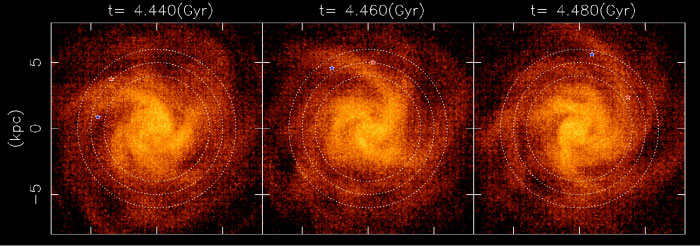According to evolutionary astronomers, the arching "arms" that protrude from spiraling galaxies are supposedly 10 billion years old.1 But because the inside stars rotate faster than the outside stars, the arms they form would have "wound up" to form a disk after only about a hundred million years. And what possible forces could have spun them out of a mass of hydrogen atoms or a clump of stars in the first place?
Postgraduate student Robert Grand of the Mullard Space Science Laboratory, University College London, recently presented a spiral galaxy model at the Royal Astronomical Society's National Astronomy Meeting in Wales. The model attempted to digitally simulate the origin of the arms in spiral galaxies.
Grand said in an RAS press release, "We have found it impossible to reproduce the traditional theory, but stars move with the spiral pattern in our simulations at the same speed."2 The "traditional theory" held that stars are channeled into arms by "density waves." However, this explanation merely pushes the problem back one step to another puzzle—what caused the density waves? And clearly, Grand was unable to make the physics of the "traditional theory" of density waves work in his simulations.
His replacement model appears to be based on spiral density waves, but his version, used to model a Milky Way-size galaxy, showed how stars could rotate within each galactic arm. After 100 million years, "the arm breaks up due to the shear forces."2 This is consistent with what physicist Dr. D. Russell Humphreys wrote in 2005 when he briefly described the winding galaxy problem:
The stars of our own galaxy, the Milky Way, rotate about the galactic center with different speeds, the inner ones rotating faster than the outer ones. The observed rotation speeds are so fast that if our galaxy were more than a few hundred million years old, it would be a featureless disc of stars instead of its present spiral shape.1 (emphasis in original)
Thus, neither the traditional density waves nor this new spiral density wave model show that the spiral arms could last anywhere near the 10 billion years that evolutionists have assigned to many distant galaxies.
But Grand did suggest an escape from this problem. His presentation abstract stated, "We find that the spiral arms are recurrent material features, and the pattern speed generally decreases with radius, in such a way that the pattern speed almost equals the rotation speed of stars at all radii."3
Though the spiral arms may be "recurrent" in his simulations, real spiral galaxies within the universe do not show stages of arms forming, collapsing, and reforming. Actual galaxies either have strongly defined spiral arms, like the ones in Galaxy M81, or arms that have partly or totally blurred into one another. There are no examples in the skies of new arms forming, and this new model did not produce the clear spiral arms that telescopes have revealed.
Humphreys noted this mismatch between the way real galaxies look and the virtual galaxies in Grand's model, shown here:

Image credit: Robert Grand. Copyright © 2011 Royal Astronomical Society.
In a recent email, Humphreys wrote:
I notice that the spirals of their simulations are very poorly defined, with not much fewer stars per unit area between the arms compared to the number per unit area in the arms, and very blurry boundaries. But many real galaxies have very clearly defined spiral arms.4
Humphreys also noted that without access to the details of Grand's model, it is impossible to discern if the claim of rapid spiral arm formation is the product of wishful thinking, unrealistic tweaking of physics parameters, or real physics. But since Grand's model produced such a weak facsimile, there is little reason to trust it.
Thus, a realistic way for natural processes alone to produce spiral arms has yet to be discovered. And spiral galaxies still don't look anywhere near as old as the "nature is all there is" advocates claim. Spiral galaxies still look like relatively youthful, intentional creations.
References
- Humphreys, D. R. 2005. Evidence for a Young World. Acts & Facts. 34 (6).
- NAM 21: New theory of evolution for spiral galaxy arms. Royal Astronomical Society press release, April 20, 2011.
- Grand, R. Analysing stellar motions and spiral arm formation in spiral galaxies. Presented at the Royal Astronomical Society National Astronomy Meeting 2011 in Llandudno, North Wales, April 17-21.
- Humphreys, D. R. Personal communication, April 25, 2011.
Image credit: NASA/JPL
* Mr. Thomas is Science Writer at the Institute for Creation Research.
Article posted on May 5, 2011.










